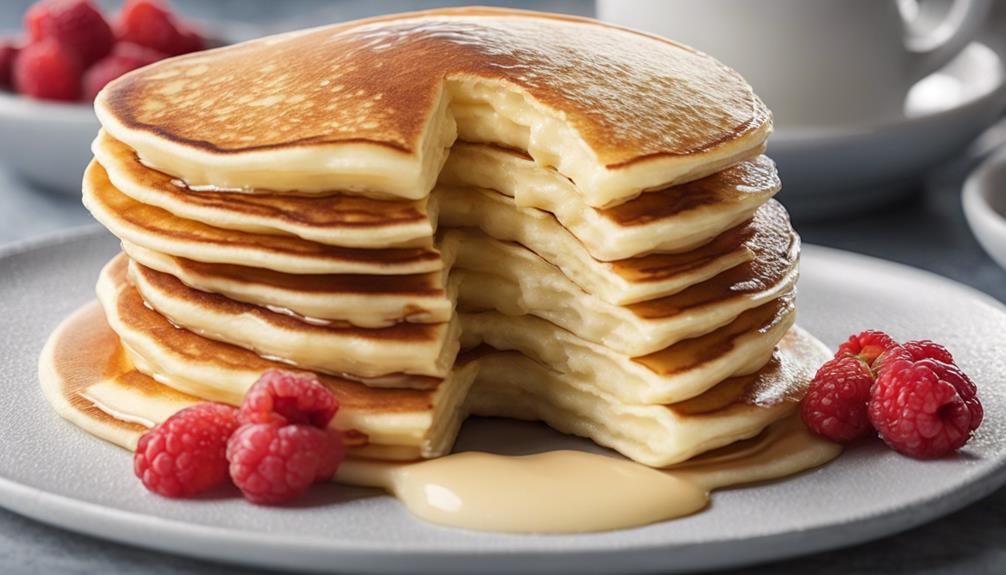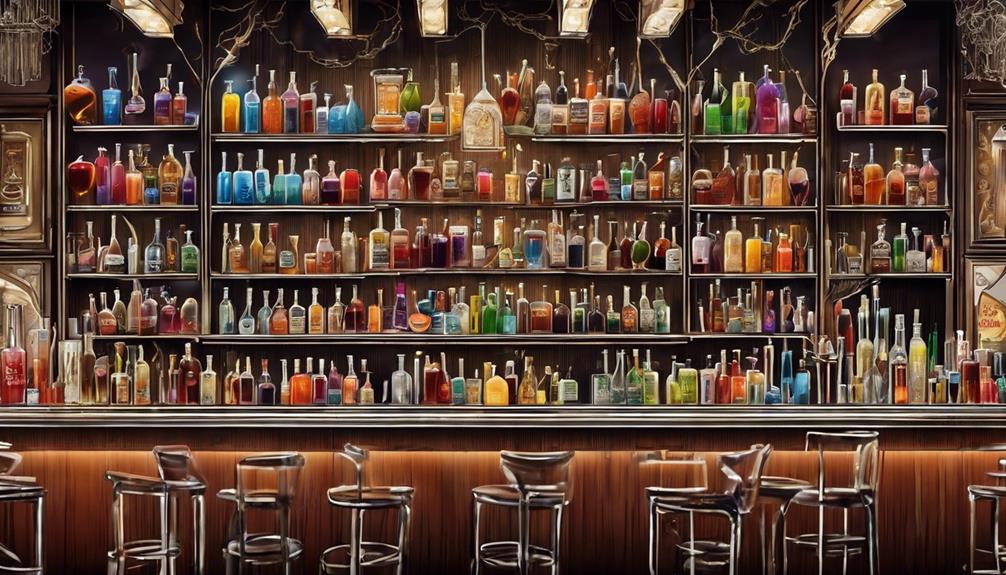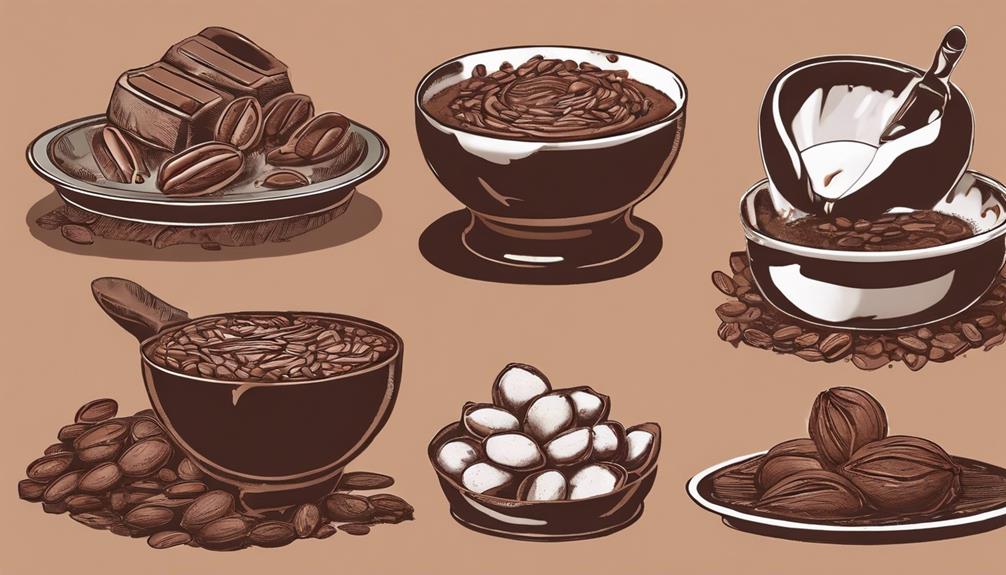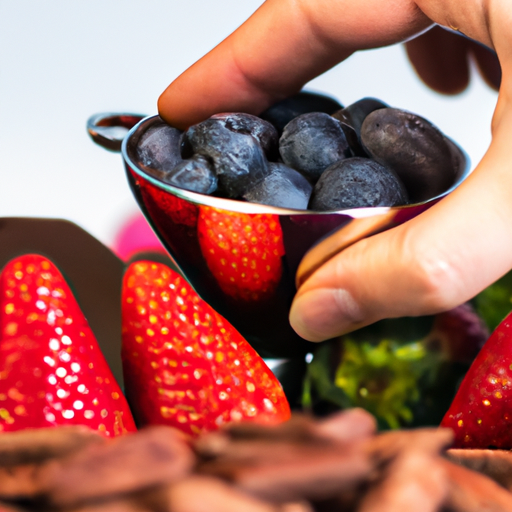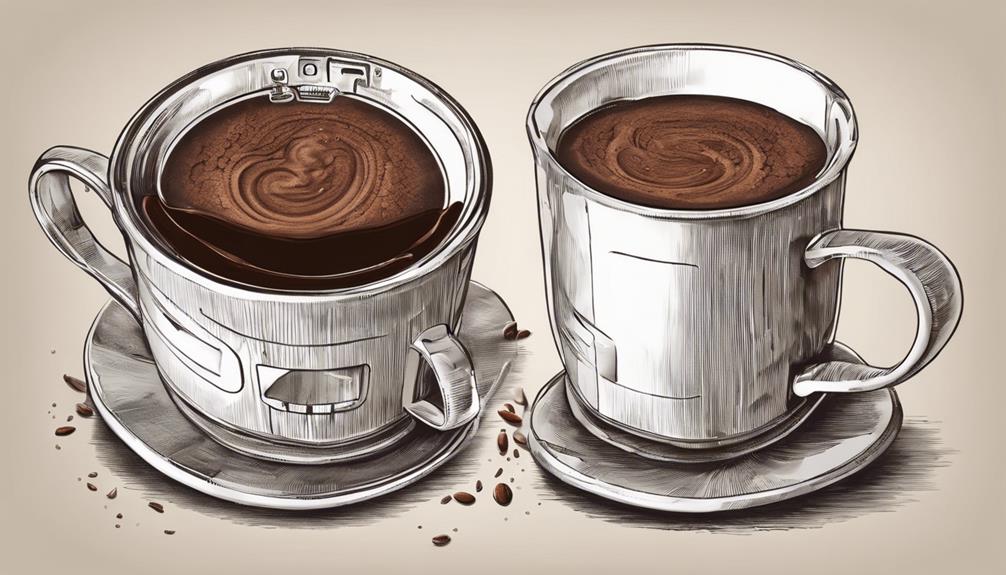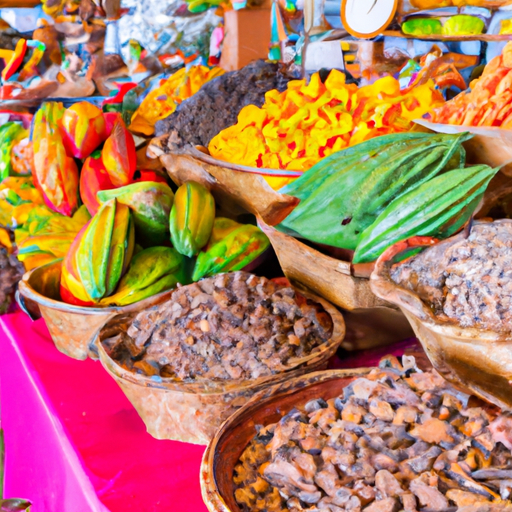Pancakes and hotcakes differ in terms of their thickness, ingredients, and cooking methods, setting them apart in culinary customs around the world. Pancakes are recognized for their thin, fluffy texture and usually consist of flour, eggs, milk, sugar, and leavening agents. On the other hand, hotcakes are thicker and denser, often incorporating ingredients such as buttermilk or cornmeal, which influence their flavor and texture. Additionally, the cooking techniques vary: pancakes require high heat for fluffiness, while hotcakes need lower heat and a longer cooking time for a denser result. By understanding these differences, you can better appreciate the unique qualities of each delicious treat.
Key Takeaways
- Pancakes are thin and fluffy, while hotcakes are thick and dense.
- Ingredients for pancakes include flour, eggs, milk, and leavening agents.
- Hotcakes may have variations like buttermilk or cornmeal for a denser texture.
- Cooking techniques differ: pancakes need high heat for fluffiness, hotcakes require lower heat for density.
- Regional variations exist, with European hotcakes being thicker and denser than American pancakes.
Origin of Pancakes and Hotcakes
The ancient origins of pancakes and hotcakes intertwine with the culinary evolution of early civilizations, reflecting a timeless tradition of simple yet satisfying fare. American pancakes, also known as griddle cakes, have roots that trace back to prehistoric times when individuals crafted thin cakes from a mixture of flour and water. These Stone Age cooks likely cooked these pancakes on hot rocks, showcasing the long and rich history of this beloved dish.
Across centuries and cultures, pancakes have been enjoyed globally, becoming a staple food that transcends borders and time. The exact beginnings of pancakes may be challenging to pinpoint definitively due to their widespread popularity and diverse adaptations. Nonetheless, the enduring appeal of pancakes throughout history highlights their significance as a comforting and versatile dish that continues to bring joy to people worldwide.
Ingredients Variation in Pancakes and Hotcakes
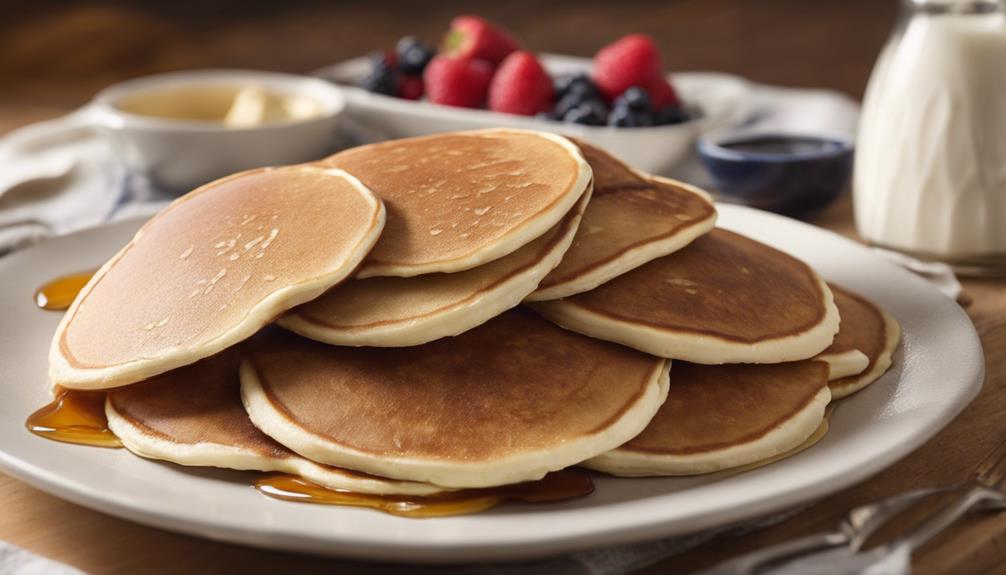
Exploring the ingredient variations between pancakes and hotcakes reveals subtle distinctions in texture and flavor profiles. Pancakes commonly consist of a batter made with flour, eggs, milk, sugar, and leavening agents.
On the other hand, hotcakes share similar ingredients but are known for being thicker and denser in texture. Hotcakes may also deviate by incorporating ingredients like buttermilk or cornmeal, contributing to a unique flavor profile. The ratio of ingredients in hotcakes can be adjusted to achieve varying levels of fluffiness or density compared to traditional pancakes.
Both pancakes and hotcakes offer a canvas for personalization, allowing for a wide range of toppings such as syrup, fruits, nuts, or chocolate chips based on individual preferences. Experimenting with these ingredient variations can lead to discovering the perfect balance of flavors and textures in your pancakes or hotcakes.
Cooking Techniques for Pancakes and Hotcakes
Comparing the cooking techniques for pancakes and hotcakes reveals distinct differences in method and outcome. When cooking pancakes, it's crucial to preheat a griddle or frying pan on high heat. This high temperature helps create that fluffy texture we all love. Pour the pancake batter onto the hot surface and cook until bubbles form on the surface before flipping them over. This quick cooking process guarantees a light and airy pancake.
On the other hand, cooking hotcakes requires a lower heat setting and a longer cooking time. The batter for hotcakes is often thicker, leading to a denser texture. To achieve this, cook the hotcakes slowly, flipping them only once to ensure they're cooked through. The longer time on the griddle allows for a thicker consistency and may result in a slightly caramelized exterior, adding a unique flavor profile.
Thickness Contrast in Pancakes Vs. Hotcakes
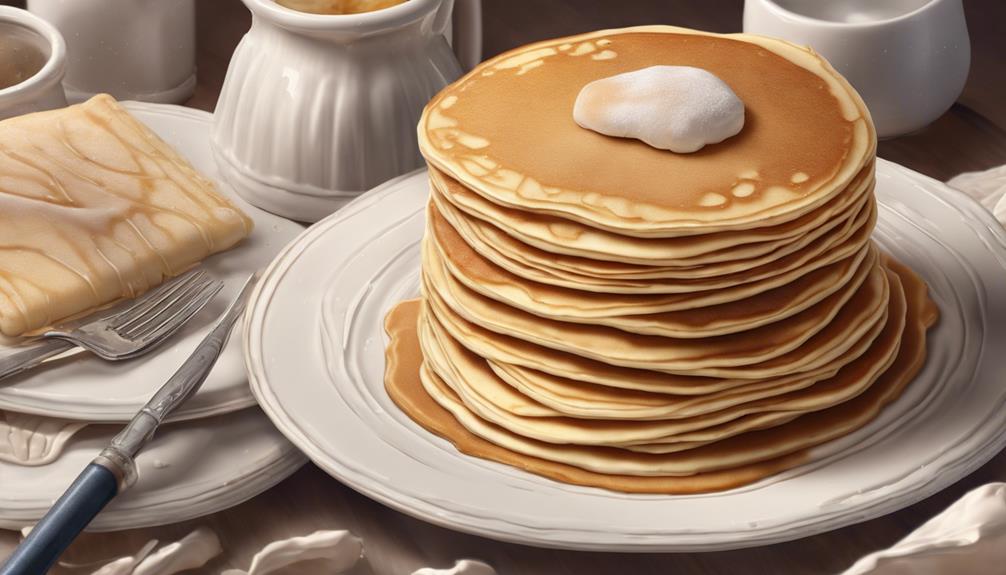
In breakfast choices, one can notice a distinctive contrast in thickness between pancakes and hotcakes. Hotcakes are typically thicker than traditional pancakes, resulting in a denser texture when cooked. On the other hand, pancakes are known for their fluffiness and tend to be thinner compared to hotcakes. This difference in thickness between hotcakes and pancakes plays a significant role in various aspects of their preparation and enjoyment. For instance, hotcakes may require longer cooking times to guarantee the center is fully cooked due to their thickness, while pancakes cook relatively faster due to their thinner nature.
Moreover, the thickness of hotcakes versus pancakes can also affect how toppings and syrups are absorbed and enjoyed. The denser texture of hotcakes allows them to hold toppings differently than the fluffier pancakes, influencing the overall taste experience. Understanding this contrast in thickness can help you appreciate the unique characteristics of both hotcakes and pancakes when making your breakfast choice.
Regional Variations in Pancakes and Hotcakes
In understanding the differences between pancakes and hotcakes, it's crucial to take into account regional variations that affect their ingredients and cooking methods. These variations can impact the texture, thickness, and overall taste of the final product.
Exploring how different regions prepare and enjoy their pancakes or hotcakes can offer valuable insights into the diverse culinary traditions around the world.
Ingredient Variations
What unique ingredient variations distinguish pancakes and hotcakes across different regions?
- Some regions prefer hotcakes made with cornmeal or buttermilk for a distinctive flavor.
- Hotcakes can be denser and sweeter than traditional pancakes due to unique regional recipes.
- The use of local ingredients and cultural influences leads to significant differences in flavor profiles.
- Regional variations impact the texture, thickness, and overall taste of pancakes and hotcakes.
Cooking Methods
When preparing pancakes and hotcakes, regional variations in cooking methods play a significant role in determining their texture and taste profiles. In the US, pancakes are commonly cooked on a griddle or frying pan, while hotcakes may undergo longer cooking times at higher temperatures. European hotcakes are often prepared on a griddle or skillet, resulting in a thicker, denser texture compared to American pancakes.
Some regions opt for baking or grilling hotcakes and pancakes, introducing further diversity in cooking techniques. Factors such as cooking time, temperature, and batter thickness vary based on regional preferences, influencing the final outcome. Both pancakes and hotcakes offer opportunities for customization with diverse ingredients and toppings, reflecting unique culinary traditions and individual tastes.
Toppings and Serving Styles
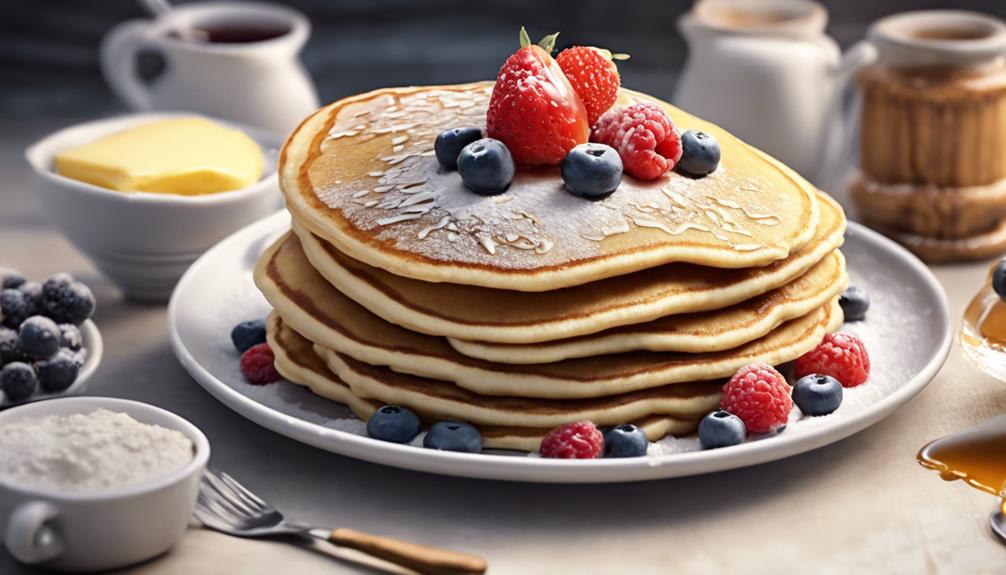
Pancakes and hotcakes offer a range of toppings and serving styles that cater to different tastes.
Syrup or gravy, sweet or savory, stacked or plated – these choices can significantly alter the flavor and presentation of your breakfast.
Understanding these variations can help you appreciate the nuances between pancakes and hotcakes.
Syrup Vs Gravy
Typically, syrup is drizzled over pancakes for a sweet touch, while hotcakes are often smothered in savory gravy for a rich and hearty flavor.
- Syrup: Syrup is a classic choice for pancakes, offering a sweet and sticky topping that complements the fluffy texture of the pancake.
- Gravy: Hotcakes, on the other hand, are commonly enjoyed with savory gravies like sausage gravy, adding a savory depth to the dish.
- Varieties: Syrup comes in various flavors such as maple, fruit-infused, or even chocolate, catering to different taste preferences.
- Complementing Flavors: Gravies for hotcakes can range from creamy white gravy to meat-based options, enhancing the overall richness and heartiness of the meal.
Sweet Vs Savory
As we explore the contrast between sweet and savory toppings for pancakes and hotcakes, the variety of flavor options becomes apparent. Pancakes are typically enjoyed with sweet toppings like syrup, fruits, whipped cream, or even chocolate chips, creating a delightful treat for those with a sweet tooth.
On the other hand, hotcakes offer a savory alternative, pairing well with toppings such as bacon, eggs, cheese, or even vegetables, appealing to those who prefer a more savory flavor profile. While some may opt for the classic combination of butter and maple syrup on their pancakes, hotcakes provide a broader range of savory options, catering to diverse taste preferences.
Whether you lean towards sweet indulgence or savory satisfaction, both pancakes and hotcakes offer a versatile canvas for a delicious meal experience.
Stack Vs Plated
In my experience, stacking pancakes creates a visually striking presentation with a variety of toppings, while hotcakes are traditionally served plated for a simpler and more straightforward dining experience.
- When pancakes are stacked, toppings like butter, syrup, fruits, and whipped cream can be layered between each pancake, offering a delightful mix of flavors in every bite.
- Hotcakes, on the other hand, are usually served on a single plate, topped with syrup and butter, making them convenient to eat without the need for cutting through layers.
- The stacked presentation of pancakes allows for a more customizable and decorative approach, perfect for those who enjoy visually appealing meals.
- Plated hotcakes focus on simplicity, making them a quick and easy option for a satisfying breakfast or snack.
Historical Evolution of Pancakes and Hotcakes

The evolution of pancakes and hotcakes throughout history showcases their enduring popularity and culinary significance. While the exact origins of these beloved dishes remain somewhat mysterious, historical records suggest that our prehistoric ancestors enjoyed some form of pancake. The simplicity and versatility of pancakes and hotcakes have allowed them to adapt and evolve over centuries, with variations in ingredients and cooking methods reflecting diverse cultural influences.
Imagine Stone Age cooks preparing pancakes on hot rocks, utilizing the most basic of tools to create a satisfying meal. This early ingenuity laid the foundation for the pancakes and hotcakes that are familiar today. Despite the passage of time, these breakfast staples have maintained their appeal, standing the test of time as beloved options for countless generations.
The historical evolution of pancakes and hotcakes not only highlights their staying power but also underscores their universal appeal across different cultures and time periods. These humble yet delicious creations continue to bring joy and comfort to people worldwide, making them a cherished part of our culinary heritage.
Cultural Significance of Pancakes and Hotcakes
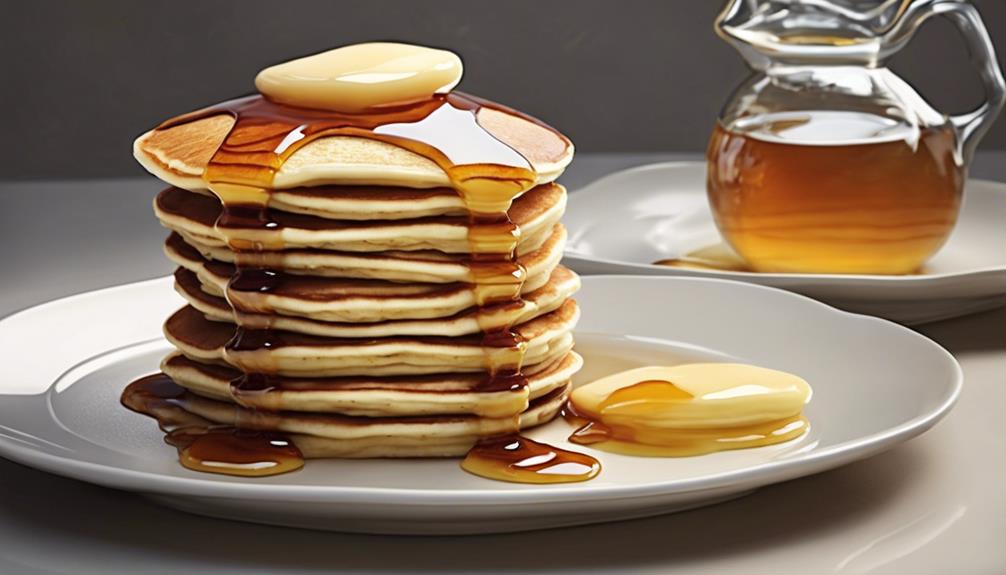
Exploring the cultural significance of pancakes and hotcakes exposes their widespread popularity and enduring presence in culinary traditions worldwide.
- Pancakes and hotcakes hold a special place in many cultures, symbolizing warmth, comfort, and togetherness around the breakfast table.
- Different types of pancakes like crepes, blinis, and dosas showcase the diversity of recipes and cooking methods across various regions.
- Toppings such as maple syrup in North America, lemon and sugar in the UK, or savory fillings in Asia reflect the adaptability of pancakes to local tastes.
- Festivals like Pancake Day in the UK and Mardi Gras in the US demonstrate how these fluffy treats are woven into the fabric of celebratory traditions worldwide.
These delectable treats not only satisfy our taste buds but also serve as a reminder of the rich cultural tapestry that connects us through shared culinary experiences.
Popular Pancake and Hotcake Recipes
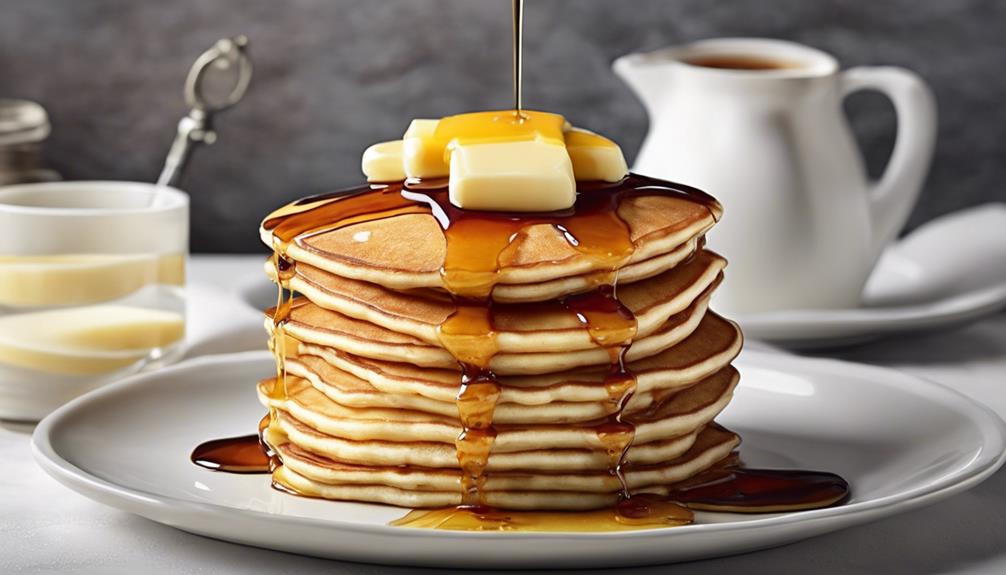
Exploring the domain of pancake and hotcake recipes reveals a universe of delicious possibilities for breakfast enthusiasts. When it comes to making these delightful treats, there are subtle differences in ingredients and cooking techniques that set them apart. Below is a comparison table highlighting the key variances between pancakes and hotcakes:
| Aspect | Pancakes | Hotcakes |
|---|---|---|
| Thickness | Typically thinner and fluffier | Often thicker and denser |
| Cooking Time | Cooked relatively quickly | Cooked longer for a browner surface |
| Marketing | Common term in the US | May be marketed as 'hotcakes' |
Whether you prefer the light and airy texture of pancakes or the hearty and robust nature of hotcakes, both can be enjoyed with a variety of delicious toppings. From classic maple syrup to decadent chocolate and fruits, the possibilities are endless. Experiment with different recipes to find your perfect pancake or hotcake creation.
Frequently Asked Questions
What Is the Difference Between Pancakes and Hotcakes?
When I think about pancakes and hotcakes, I see a subtle distinction that's more about texture. Pancakes are light and fluffy, while hotcakes are thicker and denser. It's like a delightful secret in each bite.
Why Are They Called Hotcakes and Not Pancakes?
Why are they called hotcakes and not pancakes? The term 'hotcakes' invokes a sense of warmth and comfort, appealing to our desire for a delicious, steaming breakfast treat. It's a cozy name that hints at a delightful experience.
Are Mcdonald's Hotcakes Just Pancakes?
Yes, McDonald's hotcakes are basically pancakes. They might be a bit thicker and fluffier than traditional pancakes. They're usually served with syrup and butter. Hotcakes at McDonald's are a popular breakfast choice.
Is Hotcake Mix the Same as Pancake Mix?
Hotcake mix and pancake mix are fundamentally the same, requiring liquid ingredients like eggs, milk, and butter to make the batter. The names may vary based on regional or brand preferences, but both mixes yield fluffy hotcakes or pancakes when prepared correctly.
What are the Key Differences Between Pancakes and Hotcakes?
The contrasts between hotcakes and pancakes lie in their preparation and texture. Pancakes are typically made with a leavening agent, resulting in a fluffier texture, while hotcakes are denser. Additionally, hotcakes are often cooked on a griddle with butter, while pancakes are typically cooked in a skillet.
Conclusion
To sum up, while pancakes and hotcakes may seem similar, there are subtle differences that set them apart. Think of pancakes as fluffy clouds and hotcakes as hearty bricks – both delicious in their own unique way.
Whether you prefer the thin and crispy texture of pancakes or the thick and fluffy consistency of hotcakes, there's a variety of options to satisfy your breakfast cravings. Explore the world of pancakes and hotcakes to discover your favorite!

